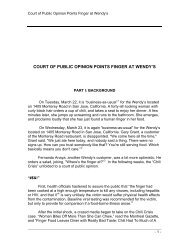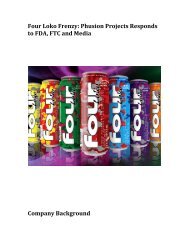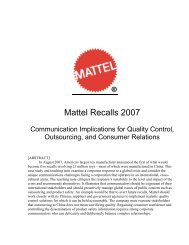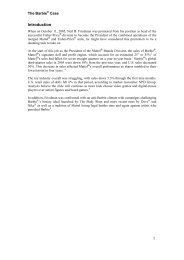The Barbie Case - The Arthur Page Society
The Barbie Case - The Arthur Page Society
The Barbie Case - The Arthur Page Society
Create successful ePaper yourself
Turn your PDF publications into a flip-book with our unique Google optimized e-Paper software.
and anti-<strong>Barbie</strong> crusaders, but Mattel®’s intention was for her<br />
to have more of a teenage physique. In order for hip-huggers,<br />
the doll’s debut outfit, to look right, <strong>Barbie</strong>® needed to be more<br />
like a teen’s body. <strong>The</strong> fashions teens were wearing didn’t fit<br />
properly on <strong>Barbie</strong>®’s current sculpting. 67<br />
In 1998, Mattel® sent <strong>The</strong> Body Shop a cease-and-desist order,<br />
demanding they pull the images of Ruby from American shop<br />
windows. “Ruby was making <strong>Barbie</strong>® look bad, presumably by<br />
mocking the plastic twig-like bestseller.” According to <strong>The</strong><br />
Body Shop’s founder, Anita Roddick, the idea of one inanimate<br />
piece of molded plastic hurting another’s feelings was<br />
absolutely mind-blowing.” 68<br />
A FAQ posted on Mattel®’s consumer relations website<br />
acknowledged <strong>Barbie</strong>®’s measurements:<br />
<strong>Barbie</strong>® doll is not scaled to human measurements. <strong>The</strong><br />
<strong>Barbie</strong>® doll was developed after Mattel studied the<br />
popularity of paper fashion dolls (which had more<br />
adult-like figures than the dolls of the day) among<br />
children. Finding the marketplace receptive to the idea, a<br />
team of Mattel® employees translated the paper doll<br />
concept into a three dimensional doll with life-like<br />
characteristics. 69<br />
Exhibit 8: Nike®<br />
“What Story Does Your Body Tell?” Campaign<br />
Screen shot of Nike ® Women Campaign Websit 86<br />
“My Butt is Big” Story from the Nike ® Ad Campaign 87<br />
arthur w. page society<br />
As of yet, Mattel® has not officially responded to the Dove® and<br />
Nike® campaign ads launched in 2005. <strong>The</strong>re have been no<br />
mentions of the campaigns in Mattel® and <strong>Barbie</strong>® press releases<br />
and Mattel® spokespeople have not officially commented on<br />
the campaigns. Mattel® has not started lawsuits either, most<br />
likely because the campaigns indirectly attack <strong>Barbie</strong>®’s beauty<br />
ideal, as opposed to <strong>The</strong> Body Shop Ruby campaign.<br />
Response to Competition: Bratz<br />
Mattel®’s initial response to Bratz was so slow and<br />
ineffective. This was due to the company’s internal challenges<br />
such as the catastrophic acquisition of the Learning Company<br />
distracting management as well as its disinclination to change<br />
its key product. Long-running successes such as the <strong>Barbie</strong>®<br />
doll can make managers at large companies such as Mattel®<br />
near-sighted: “Focused on a mainstay product, they tend to<br />
ignore fresh information that diverges from their accepted<br />
norm in three basic areas: marketplace trends, the interests of<br />
target consumers, and threats from competitors.” 70<br />
Due to Mattel®’s decisions and actions in the <strong>Barbie</strong>® – Bratz<br />
battle, Mattel® found itself again in a few lawsuits. On April 13,<br />
2005, Isaac Larian, the creator of Bratz sued Mattel® in<br />
federal court, accusing the world’s largest toymaker of unfair<br />
competition, intellectual property infringement, and “serial<br />
copycatting.” <strong>The</strong> suit claimed that Mattel®’s My Scene and<br />
Flava (see Exhibit 10) <strong>Barbie</strong>® dolls “mimic the look, themes,<br />
and packaging of Bratz. It also alleges that Mattel® has<br />
threatened retailers and licensees with retribution if they do<br />
business with MGA Entertainment and that Mattel® tried to<br />
lock up the supply of doll hair.” Suits such as these are difficult<br />
to win because the plaintiff has to prove that shoppers were<br />
confused and that its business suffered. Mattel® said it would<br />
vigorously defend itself and considered this suit retaliation for<br />
its own legal claim: that doll designer Carter Bryant came up<br />
with the idea for Bratz while still working at Mattel®. 71<br />
Response to Parody/Homage:<br />
Music, Advertising and Fine Arts<br />
Instead of engaging in a meaningful discussion about <strong>Barbie</strong>®<br />
in the media, it seems that Mattel® again only uses the strategy<br />
of taking the other party to court. In the case of the following<br />
three cases of parody, this strategy obviously did not work.<br />
First, Mattel® filed a trademark infringement and defamation<br />
lawsuit on September 11, 1997 against Aqua’s song “<strong>Barbie</strong>®<br />
Girl” in which the Danish band used lyrics such as “You can<br />
brush my hair/Undress me everywhere” and used graphics<br />
similar to the pink <strong>Barbie</strong>® logo. This lawsuit was dismissed by<br />
the court as parody on May 15, 1998. 72<br />
11














